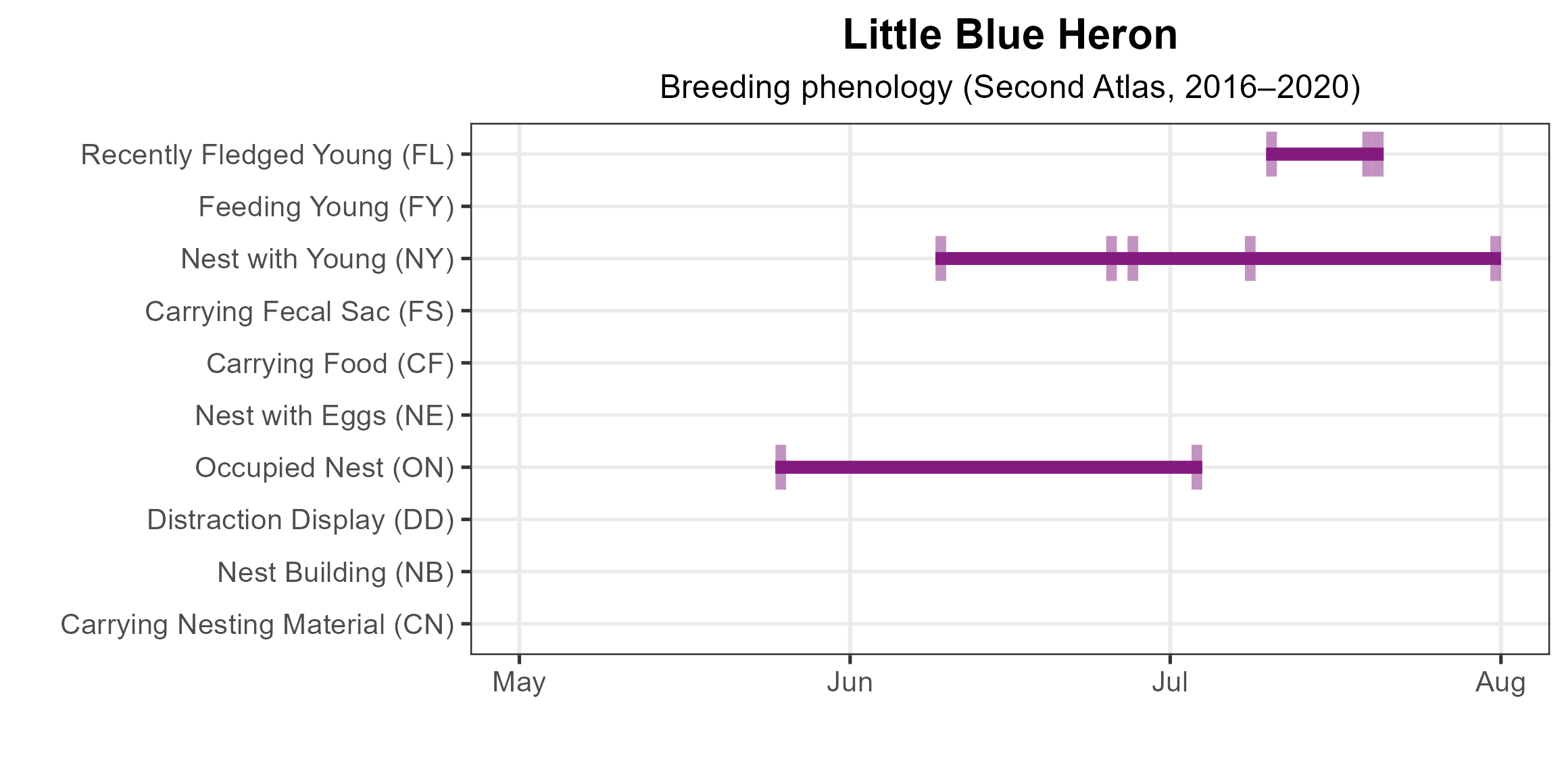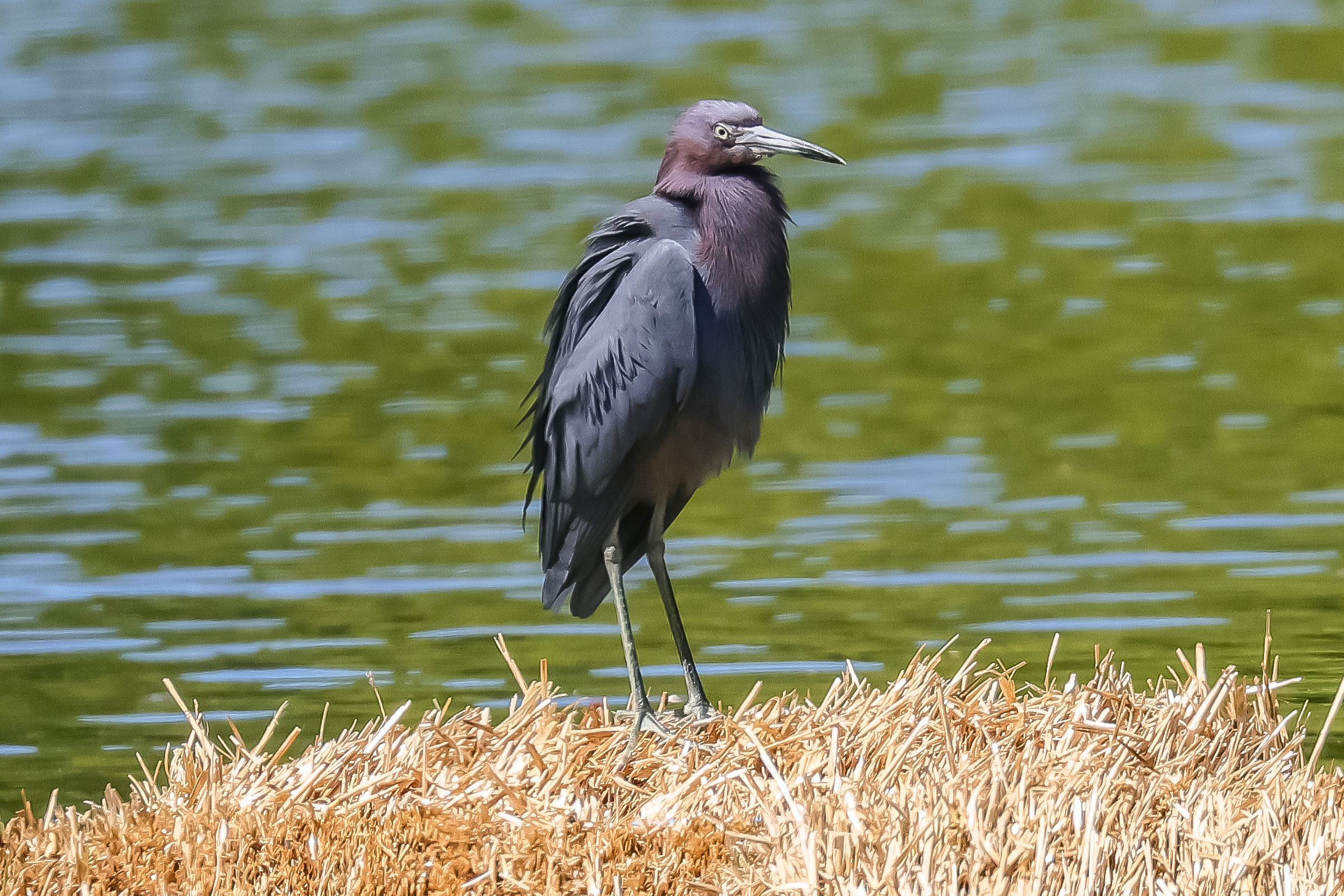Introduction
The Little Blue Heron often fails to stand out among feeding flocks in its immature white plumage until it molts into its full-body slate blue palette as an adult. It patiently hunts the shallows of Virginia’s fresh and brackish coastal lagoons, wandering inland and upriver as summer ends. In Virginia, it nests in rookeries that also include Snowy Egrets (Egretta thula), Tricolored Herons (Egretta tricolor), Great Egrets (Ardea alba), and Glossy Ibis (Plegadis falcinellus), among others. These birds are serene but can hold their ground. In a study of colonial-nesting birds in Virginia, Little Blue Herons were the least aggressive but most successful at winning inter-species encounters at the colony (Frohring 1981).
The Little Blue Heron is a fairly common breeder in the Coastal Plain but uncommon to fairly rare elsewhere during the post-breeding season and into winter (Rottenborn and Brinkley 2007). It historically bred along the tributaries of the James River, specifically at Jamestown and along the Chickahominy River (Bailey 1913), but populations have dwindled and today only occupy a few sites.
Breeding Distribution
The Little Blue Heron was well-covered during the Second Atlas by the 2018 Virginia Colonial Waterbird Survey, a coastal census conducted by the Center for Conservation Biology (CCB) in collaboration with the Virginia Department of Wildlife Resources (VDWR) and The Nature Conservancy (TNC). The survey identifies nesting locations of this and other species that breed in colonies. Because the Little Blue Heron only breeds within the survey area, there was no need to model its distribution. For information on where the species occurs in Virginia’s Coastal Plain, please see the Breeding Evidence section.
Breeding Evidence
The Little Blue Heron nests exclusively within the survey area covered by the Virginia Colonial Waterbird Survey in 2018, and this survey documented the locations of breeding colonies of this species. Therefore, the species is unlikely to have nested in blocks without confirmed breeding evidence. Additional breeding confirmations were reported by Atlas volunteers in other years of the Second Atlas period.
Little Blue Herons were confirmed breeders in four blocks and two counties, all on the Eastern Shore (Figure 1). Most of the population in 2018 was nesting on Wreck Island (Northampton County) and the Chincoteague Causeway (Accomack County) (Watts et al. 2019). In the Chesapeake Bay, there are also two colonies on Tangier Island (Accomack County). Inland records during the Atlas were primarily birds foraging away from a colony in otherwise appropriate breeding habitat or birds wandering inland along the James River during post-breeding dispersal. During the First Atlas, the species was confirmed in nine blocks on the Eastern Shore (Figure 2).
Because the species was so seldom observed, it is difficult to describe their breeding phenology. Birds were on nests at colonies by May 25 (Figure 3). Young were observed in nests from June 9 to July 31. For more general information on the breeding habits of the Little Blue Heron, please refer to All About Birds.

Figure 1: Little Blue Heron breeding observations from the Second Atlas (2016–2020). The colored boxes illustrate Atlas blocks (approximately 10 mi2 [26 km2] survey units) where the species was detected. The colors show the highest breeding category recorded in a block. The numbers within the colors in the legend correspond to the number of blocks with that breeding evidence category. Nesting is unlikely outside of confirmed blocks.

Figure 2: Little Blue Heron breeding observations from the First Atlas (1985–1989). The colored boxes illustrate Atlas blocks (approximately 10 mi2 [26 km2] survey units) where the species was detected. The colors show the highest breeding category recorded in a block. The numbers within the colors in the legend correspond to the number of blocks with that breeding evidence category.

Figure 3: Little Blue Heron phenology: confirmed breeding codes. This graph shows a timeline of confirmed breeding behaviors. Tick marks represent individual observations of the behavior.
Population Status
The Little Blue Heron had too few detections during the Atlas point count surveys to develop an abundance model. However, the distribution and size of Little Blue Heron colonies derived from the 2018 Virginia Colonial Waterbird Survey are displayed on the CCB Mapping Portal.
Virginia Colonial Waterbird Surveys indicate that Little Blue Herons declined by 72% from 374 pairs to 104 pairs between 1993 and 2023 (Watts et al. 2018; Watts et al. 2024). However, the population estimate has increased from 64 to 104 pairs over the past five years. Nearly 83% of the population in 2023 was nesting within the seaside region on Wreck Island and in the Chincoteague Bay marshes. The remaining pairs nested on Watts and Tangier Islands in the Chesapeake Bay (Watts et al. 2024).

Figure 4: Little Blue Heron population trend for Virginia’s Coastal Plain. This chart illustrates the number of breeding pairs as estimated by the Virginia Colonial Waterbird Survey (Watts et al. 2024). A data point is not included for 1998, as the Survey covered a smaller geographic area in that year. The vertical light blue bars represent the periods corresponding to the First Atlas (1985–1989) and Second Atlas (2016–2020).
Conservation
Major threats to Little Blue Herons are loss of foraging habitat and ensuing lack of prey to raise offspring (Rodgers and Smith 2020). Habitat loss is driven by not only coastal development but also erosion of islands due to sea-level rise, a critical threat to Little Blue Herons (Watts et al. 2019). Most breeding sites are protected and subject to management including area closures, predator management, and outreach. The CCB, VDWR, TNC, and U.S. Fish and Wildlife Service monitor Little Blue Herons and other colonial waterbirds in the Coastal Plain. Additionally, the 2025 Virginia Wildlife Action Plan includes the Little Blue Heron as a Tier I Species of Greatest Conservation Need (Critical Conservation Need), indicating that they are at a high risk of extirpation in the state (VDWR 2025).
Interactive Map
The interactive map contains up to six Atlas layers (probability of occurrence for the First and Second Atlases, change in probability of occurrence between Atlases, breeding evidence for the First and Second Atlases, and abundance for the Second Atlas) that can be viewed one at a time. To view an Atlas map layer, mouse over the layer box in the upper left. County lines and physiographic regional boundaries (Mountains and Valleys, Piedmont, and Coastal Plain) can be turned on and off by checking or unchecking the box below the layer box. Within the map window, users can hover on a block to see its value for each layer and pan and zoom to see roads, towns, and other features of interest that are visible beneath a selected layer.
View Interactive Map in Full Screen
References
Bailey, H. H. (1913). The Birds of Virginia. J.P. Bell Company, Incorporated, Lynchburg, VA, USA.
Frohring, P. C. (1981). Aspects of colonial nesting in four species of herons in Virginia. Master’s thesis, College of William and Mary. Williamsburg, VA, USA.
Hostetler, J. A., J. R. Sauer, J. E. Hines, D. Ziolkowski, and M. Lutmerding (2023). The North American breeding bird survey, analysis results 1966–2022. U.S. Geological Survey, Laurel, MD, USA. https://doi.org/10.5066/P9SC7T11.
Rodgers, J. A. Jr., and H. T. Smith (2020). Little Blue Heron (Egretta caerulea), version 1.0. In Birds of the World (A. F. Poole, Editor). Cornell Lab of Ornithology, Ithaca, NY, USA. https://doi.org/10.2173/bow.libher.01.
Rottenborn, S. C., and E. S. Brinkley (Editors) (2007). Virginia’s birdlife: An annotated checklist. 4th edition. Virginia Society of Ornithology.
Virginia Department of Wildlife Resources (VDWR) (2025). Virginia wildlife action plan. Virginia Department of Wildlife Resources, Henrico, VA, USA. 506 pp.
Watts, B. D., B. J. Paxton, R. Boettcher, and A. L. Wilke (2019). Status and distribution of colonial waterbirds in coastal Virginia: 2018 breeding season. College of William & Mary and Virginia Commonwealth University CCBTR-19-06. Williamsburg, VA, USA.
Watts, B. D., B. J. Paxton, R. Boettcher, and A. L. Wilke (2024). Status and distribution of colonial waterbirds in coastal Virginia: 2023 breeding season. College of William and Mary and Virginia Commonwealth University CCBTR-24-12. Williamsburg, VA, USA.




